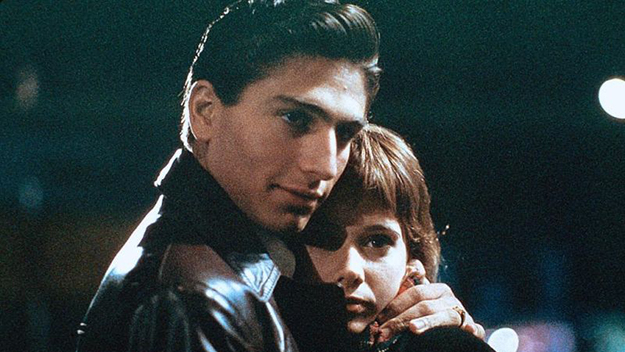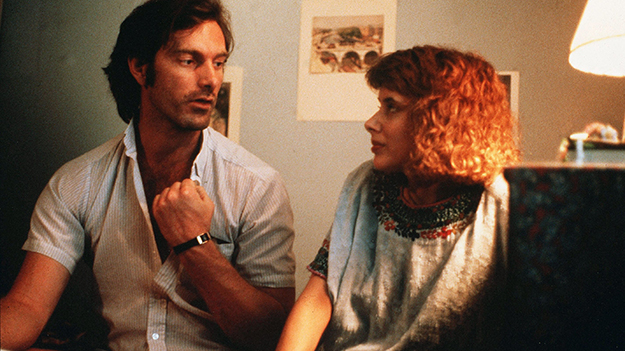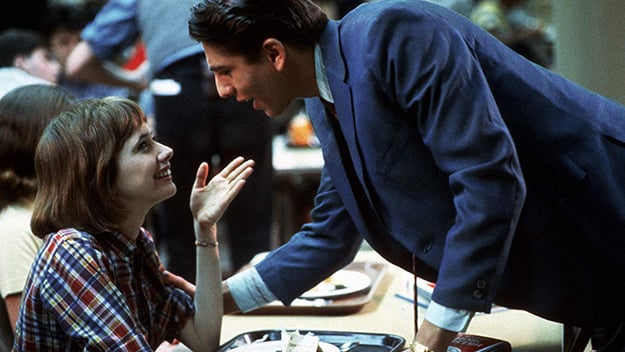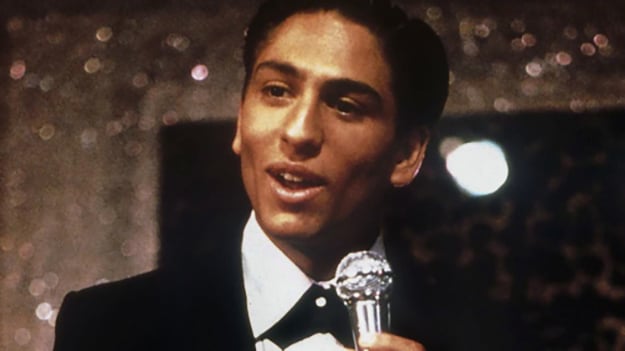Feeling Seen: John Sayles, Bruce Springsteen, and Baby It’s You
Don’t miss our free talk on Monday, November 11 at 7 p.m. Work and Class at the Movies, with John Sayles. Feeling Seen is a regular column focusing on personal reflections on films from different authors and writers.

Images from Baby It’s You (John Sayles, 1983)
I have lived in Schenectady, New York my entire life. Though the city is known for at least a few significant things, it’s primarily recognized as the home of General Electric. The traumatic ripple effect of that company’s collapse did not spare my family, many of whom experienced General Electric layoffs and the resulting destabilization. As I grew older, it became clear to me why the music of someone like Bruce Springsteen, an artist revered by my parents to the degree of sainthood, resonated so strongly in the region. His songs are not about Schenectady, but they might as well be: allusions to factory towns, economic depression, evocative scenes related to bodies of water, and the decaying facade of the American dream. Drawing connections between Springsteen’s body of work and my hometown’s history have shaped a lot of my perspective on how art and artists can give regions their own cultural import. Springsteen was important to connecting me to what it meant to be from where I came from and his music allowed me to understand my hometown more in terms of working identity than for once being a place that built everything from refrigerators to Space Age jets. Disenchanted by Schenectady’s General Electric identity, and inspired by the Boss, I tried to consider other facets of my hometown that were more positive, vital, and of interest to me. Enter John Sayles.
Sayles was also born and raised in Schenectady, New York. He cut his teeth as a filmmaker working for Roger Corman’s American International Pictures with a screenplay credit on Piranha that would help bankroll his 1980 directorial debut, Return of the Secaucus 7. Like another Corman School acolyte Jonathan Demme, Sayles had an egalitarian approach to subject matter, touching on race (The Brother from Another Planet), homosexuality (Lianna), and class and labor (Matewan). But his creative work also extended into publishing novels and short stories, accomplishments that predate his forays into filmmaking and include his 1978 National Book Award finalist Union Dues.
Despite his roots in the Electric City and his obvious interest in working class communities, Sayles has never written a major work about his (and my) hometown. On occasion, Sayles has screened his films at Schenectady’s historic Proctor’s Theatre (where I saw his 2007 film Honeydripper), and he has always returned in support of local arts and educational programs, but Schenectady has yet to play itself on screen for him. Nevertheless, it is not difficult to see the city in his work. His films and writing have dealt with labor strife in a mining town in Matewan (1987), the role of powerful corporate interests in Sunshine State (2002), the effects of economic depression on an Alaskan town in Limbo (1999), and the fantastical futility of the Flying Dutchman-like trucker in his O. Henry Award-winning story “I-80 Nebraska.” When asked about writing about the corruption of a small city in City of Hope (1991), Sayles was candid, “It wasn’t necessary to do a lot of research for this film. I’ve spent time around Hoboken, Jersey City, Albany, and other places where my story is repeated all the time.” Sayles is being modest in a way. His work is rich in the details of a specific cultural history tied to a time and place. What makes a John Sayles film unique is that his worlds are mosaics, infused with that history and local color, along with a careful mixture of irony, cynicism, and heart.

John Sayles and Rosanna Arquette on the set of Baby It’s You
Springsteen’s art shares a similar striving for universality, his voice singing a story repeated throughout history, but with grace notes grounded in a specificity that often looks beyond the songwriter’s home in the swamps of the Garden State out into the rust belt. So it makes sense that Sayles and Springsteen would collaborate, each seeing the other’s work as something they could embrace. Thought they worked together directly on three music videos in the late ’80s,at the height of MTV, they first made artistic contact in 1983. That year, Sayles released his third feature film, Baby It’s You. Set in his adopted state of New Jersey, it is a film of teenage angst in the ’60s that—quite strikingly—features as much Springsteen as it does psychedelic rock and Motown.
Baby It’s You takes place in 1966 in the suburbs of Trenton. Classic Boomer films like American Graffiti, The Wanderers, and their lesser siblings so often tied lost innocence to the early ’60s. By 1966, though, the world had experienced the JFK assassination, the Beatles hitting America, and Bob Dylan going electric. But 1966 was also before Nixon’s election, before the Summer of Love, before Woodstock, and, before the Vietnam War became synonymous in the public imagination with images of burned bodies. The nation was on the cusp of a generational shift, and the mid-’60s were sung in a transitional key. And, in 1966, Springsteen was 17 and Sayles was 16—high school kids living in a prelapsarian innocence.
Sayles’ Trenton still feels stuck in those early, innocent ’60s, full of beehive do-ups, slicked back hair, girls in long skirts, and teenage boys in button-downs and ties—a suburb lagging behind the trends. But the lack of style is made up for by the lead character, Jill Rosen (Rosanna Arquette), and her friends, who are openly profane and brash in their school’s hallways. In those halls, Jill bumps into Albert “Sheik” Capadilupo (Vincent Spano), whose reputation is legendary and whose actual status as a student at the school is unclear. Sheik also looks a little behind the times, his role model being the New Jersey–born-and-bred icon of masculinity before Springsteen: Frank Sinatra.

Jill sees Sheik next as he enters the high school cafeteria while Springsteen’s “It’s Hard to Be A Saint in the City” plays on the soundtrack. It’s a moment that underlines the clash of past and future in this 1966 present, and one that frames Spano as a total movie star (though this was not to be). The song is from Springsteen’s 1973 debut album Greetings from Asbury Park, N.J., and its lyrics are a perfect introduction and encapsulation of the character: “I could walk like Brando right into the sun, then dance just like a Casanova / With my blackjack and jacket and hair slicked sweet.” Though Sheik embodies that rebel archetype, Sayles rarely indulges in the tarnished glory associated with James Dean and his ilk. If anything, Sayles shows how rapidly that archetype was becoming outdated. When “The E Street Shuffle” plays, it’s not to crown a “boy prophet,” but to underscore Jill’s discomfort with Sheik’s idea of courtship—taking a date to a greasy spoon eatery with wood-paneled walls and cigarette smoke. The first date plays out amid some class tension, with Sheik taking Jill to the “wrong side of the tracks,” but the scene also highlights the fact that Jill wants more from a relationship than to be a prophet’s fawning acolyte.
At first glance, Baby It’s You appears to be a classic tale of the good girl and the bad boy. But the film is less about looking at the past through rose-colored glasses than it is about being in love with somebody who is deeply nostalgic and anxious about change. Sheik embodies a value system and a way of life that is dying out, and the character not only calls back to Sinatra but also to arch-chauvinist Stanley Kowalski. His treatment of Jill starts to cut into cruelty, including cheating, before his anti-authoritarian behavior escalates into the outright unlawful. The big school dance that should have seen the couple slow-dancing to Sinatra’s “Strangers in the Night” never materializes, and as Jill drives her friends home, Sheik is performing armed robbery to Springsteen’s propulsive Bo-Diddley-riffing “She’s The One,” a wounded-animal cry of missed connections.
College is where the reality of the ’60s really begins to hit. Jill takes drugs, and her stories of a comically named boyfriend become fodder for jokes about her humble “Jersey Girl” beginnings. When Jill, on spring break, visits Sheik in Miami—where’s he moved after high school—the washed-out mint greens, light blues, and soft pinks of Trenton become harsh neon colors. Shot by Michael Ballhaus, the film describes a tacky pre-Miami Vice world of fake gold-painted opulence. In this city of superficial flash, Sheik has found work as a novelty lounge act, lip-syncing Sinatra to an audience of retirees. It is a devastating reality check—his talent for mimicry runs closer to male drag than anything else—and Jill begins to realize that she no longer loves him.

They break up, and soon after Jill leaves, an increasingly disheveled and broken Sheik drives northward in his red Ford Mustang to New York, as “Adam Raised a Cain” blasts on the soundtrack. He’s on his way to see Jill, determined to seek validation, but not prepared for the alternative: disappointment. When he arrives, the two finally get their “Strangers in the Night” dance, sung by a hippie college band at Sarah Lawrence. The group begins the song as a put-on, but, as if through vicarious nostalgia, they begin to honor Sheik’s request for closure. He is a young man caught between eras, in danger of being left behind.
This union of Springsteen and Sayles tapped into anxieties of a region—the working-class rust belt and Northeast—about changing times, and, on a personal level, the nostalgic pull people feel toward dying ideals. Both the filmmaker and the singer know where they come from and the people still living there, as well as the people who left. Their brands of Americana and storytelling are easy to take for granted, if not dismiss, as they have transitioned from the new kids disrupting their respective mediums to old men representing outdated ways. Personally, however, I cannot deny that these two artists shaped my understanding of the place and time—adrift between two eras—to which I belong, and influenced my outlook on life and art as much as Sinatra and James Dean did theirs.
Due to Paramount Pictures’ interference with the film, Sayles has not embraced Baby It’s You as he has his other movies. But the film presents characters straight out of Springsteen songs, kids from small towns who grow up with ambitions and aspirations that the changing, indifferent world wants to beat out of them. Ultimately, Sayles centers open-hearted earnestness and sincerity in both Jill and Sheik, who are innocent and jaded in their own ways at the beginning. For Sayles, they are kids who want to hold on to what they wanted from one another—but never quite got—for just one last moment.
Caden Mark Gardner is a freelance film critic and writer from Schenectady, New York.







